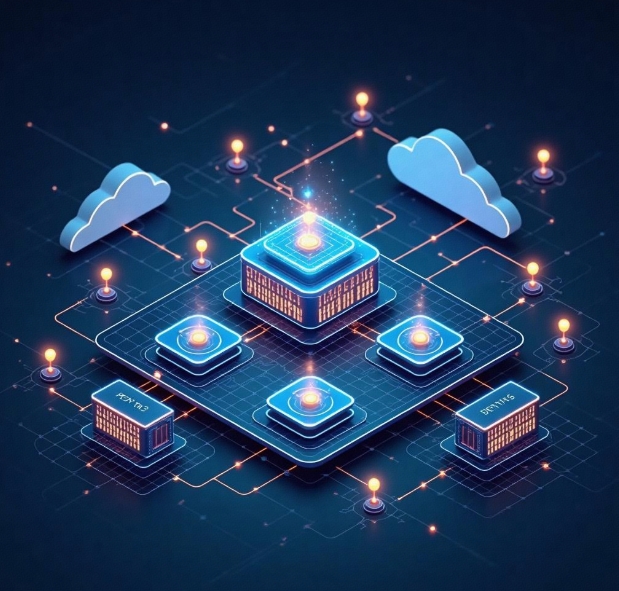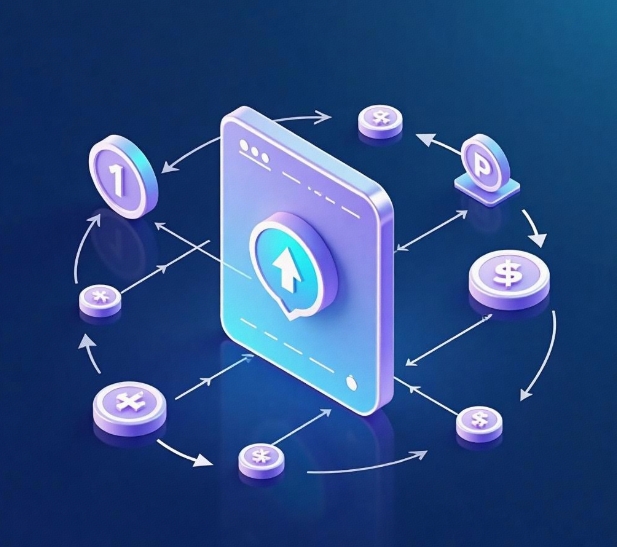Construction of a User Growth Model for Web3 Points Mall
- latest articles
- 1.DApp Development & Customization: Merging Diverse Market Needs with User Experience 2.Analysis of the Core Technical System in DApp Project Development 3.How to achieve cross-chain interoperability in Web3 projects? 4.How does the tokenization of points reconstruct the e-commerce ecosystem? 5.How to Set and Track Data Metrics for a Points Mall? 6.What is DApp Development? Core Concepts and Technical Analysis 7.Inventory of commonly used Web3 development tools and usage tips 8.Development of a Distribution System Integrated with Social E-commerce 9.Six Key Steps for Businesses to Build a Points Mall System 10.What is DApp Development? A Comprehensive Guide from Concept to Implementation
- Popular Articles
- 1.Future Trends and Technology Predictions for APP Development in 2025 2.Analysis of the DeFi Ecosystem: How Developers Can Participate in Decentralized Finance Innovation 3.From Zero to One: How PI Mall Revolutionizes the Traditional E-commerce Model 4.DAPP Development | Best Practices for Professional Customization and Rapid Launch 5.Recommended by the Web3 developer community: the most noteworthy forums and resources 6.How to Develop a Successful Douyin Mini Program: Technical Architecture and Best Practices 7.From Cloud Computing to Computing Power Leasing: Building a Flexible and Scalable Computing Resource Platform 8.Shared Bike System APP: The Convenient Choice in the Era of Smart Travel 9.How to Create a Successful Dating App: From Needs Analysis to User Experience Design 10.From Design to Development: The Complete Process of Bringing an APP Idea to Life
With the rapid development of blockchain technology, Web3 has become a hot topic across various industries, especially in the fields of the digital economy and decentralized applications (DApps). The rise of Web3 undoubtedly brings new transformations to these areas. Web3 technology not only changes the traditional internet structure but also provides users with a more secure, transparent, and decentralized online environment. Within the Web3 framework, points-based marketplaces, as an important application scenario, have garnered widespread attention.
Web3 points marketplaces not only offer users functions such as consumption, redemption, and rewards but also, through decentralized incentive mechanisms, provide more innovative potential in their operational models compared to traditional centralized e-commerce platforms. Building an effective user growth model becomes one of the keys to the success of a Web3 points marketplace. This article will explore how to construct a user growth model for a Web3 points marketplace from multiple dimensions and analyze how this model can effectively promote user activation, retention, and growth.
1. Basic Concepts and Characteristics of Web3 Points Marketplaces
1.1 Definition of Web3 Points Marketplaces
A Web3 points marketplace is a decentralized platform built on blockchain technology where users earn points rewards through specific actions or tasks. These points can be used for redeeming products within the marketplace, purchasing virtual items, or even participating in more complex ecosystems. Unlike traditional points marketplaces, Web3 points marketplaces leverage the automated execution of smart contracts, the transparency of blockchain, and the decentralized nature to ensure that all user transaction records are publicly viewable and immutable.
1.2 Characteristics of Web3 Points Marketplaces
Decentralized Management: Web3 points marketplaces are typically based on blockchain networks, eliminating centralized platform management and control. User data and transaction records are stored publicly, transparently, and immutably through smart contracts and blockchain technology.
Incentive Mechanisms: Through various mechanisms (such as task rewards, referral rewards, etc.), users can earn points or other digital assets and use these points to redeem products or services in the marketplace.
Sense of Participation and Ownership: Users are not only consumers of the platform but also potential participants and owners. By holding tokens or participating in governance, users can gain partial control and decision-making power over the platform.
Smart Contract Automation: Web3 marketplaces utilize smart contracts to automatically execute functions such as points distribution, redemption, and rewards, reducing human intervention and improving system efficiency.
2. Framework for Building a User Growth Model
The user growth model for a Web3 points marketplace should encompass multiple stages, including user acquisition, activation, retention, and viral growth. By constructing a comprehensive user growth model, the platform can achieve efficient user growth and sustainable development in a decentralized environment.
2.1 User Acquisition Model
User acquisition is the first step in the growth model of a Web3 points marketplace. No matter how well-developed the platform's functions and products are, if it cannot attract enough users, its operations will face significant challenges. The advantage of Web3 platforms in user acquisition lies in their decentralization and transparency, offering users more control and a sense of participation. Therefore, the core strategy for user acquisition should be designed around the platform's innovation, decentralized characteristics, and user incentive mechanisms.
2.1.1 Social Media and Community Building
For Web3 platforms, user acquisition should begin with social media and community building. Users of Web3 platforms are often concentrated in specific areas such as cryptocurrency communities and technology developer groups. Therefore, social media operations are crucial. By establishing highly interactive communities, the platform can maintain close connections with users and enhance their sense of belonging.
2.1.2 Partnerships and Alliances
To improve the efficiency of user acquisition, Web3 points marketplaces can collaborate with other decentralized projects and blockchain ecosystems to attract users. Through partnerships, the platform can not only draw on the user resources of partners but also leverage their reputation and technical expertise to increase its visibility.
2.1.3 Digital Asset Rewards
Web3 platforms typically feature digital currency or token ecosystems, providing unique incentives for user acquisition. By offering users a certain amount of token rewards or giving points upon initial registration, the platform can effectively attract potential users to join and participate in the activities of the points marketplace.
2.2 User Activation Model
User activation refers to the process where users, after initial registration, successfully perform at least one valuable action and become active users. For Web3 points marketplaces, user activation not only means registering and logging into the system but also participating in actual transactions and interactions on the platform.
2.2.1 Simple Initial Experience
Web3 platforms often come with a certain technical threshold, making a simple and user-friendly initial experience crucial. The platform can simplify the registration process, reduce the complexity of user operations, help new users quickly understand the basic functions of the platform, and incentivize them to make their first transaction or points redemption through reward mechanisms.
2.2.2 Tasks and Challenges
To activate users, Web3 platforms can design simple tasks or challenges that encourage users to complete specific actions (such as inviting friends, completing their first points redemption, etc.). These tasks can attract user participation by rewarding points, tokens, or virtual items, while also increasing their activity levels and loyalty to the platform.
2.3 User Retention Model
User retention is the foundation for the sustained growth of a Web3 points marketplace. To ensure users remain active on the platform over the long term, Web3 platforms need to design reasonable incentive mechanisms and diverse interaction methods that encourage users to continue using the platform and participating in its activities.
2.3.1 Long-term Incentive Mechanisms
Web3 platforms should establish long-term incentive mechanisms, such as distributing points, tokens, or other digital assets based on user activity levels, to encourage continuous participation in marketplace transactions and activities. By dynamically adjusting incentive mechanisms, the platform can maintain user interest and engagement.
2.3.2 Community Interaction and Social Features
Web3 platforms can enhance user stickiness by strengthening community building and adding social interaction features. For example, users can earn additional reward points or tokens by expressing opinions, sharing content, or participating in votes within the platform. Such social interactions not only enhance users' sense of participation but also promote the healthy development of the platform's internal ecosystem.
2.4 User Viral Growth Model
User viral growth refers to attracting more new users to the platform through referrals and sharing by existing users, creating a "word-of-mouth effect" and "network effect." The user viral growth model for Web3 points marketplaces can be achieved through reward systems.
2.4.1 Referral Reward Mechanism
Web3 points marketplaces can implement referral reward mechanisms to encourage existing users to invite new users. Whenever a new user registers through an existing user's referral link and completes certain tasks, the referrer can earn points, tokens, or other rewards. Such mechanisms effectively motivate existing users to actively promote the platform and attract more potential users.
2.4.2 Participation Rewards and Social Features
In addition to referral rewards, Web3 platforms can design more social interaction reward mechanisms. For example, users can earn points rewards by participating in discussions, helping to answer questions, or sharing marketplace activities, thereby incentivizing them to bring more activity and traffic to the platform.
3. Summary and Outlook
The user growth model for Web3 points marketplaces is not merely an extension of traditional e-commerce growth models. It requires integrating blockchain technology, decentralized characteristics, and the advantages of smart contracts to design a user growth strategy suited to the Web3 environment. Through effective user acquisition, activation, retention, and viral growth strategies, Web3 points marketplaces can achieve sustained user growth and ultimately form a self-sustaining decentralized ecosystem.
In the future, as Web3 technology matures further and market acceptance of decentralized applications increases, Web3 points marketplaces are expected to become the new norm in the e-commerce industry. The user growth models of these platforms will continuously iterate and optimize to adapt to evolving user needs and technological trends.
-

How does the tokenization of points reconstruct the e-commerce ecosystem?
With the continuous advancement of internet technology and the gradual prolifera···
-

How to Set and Track Data Metrics for a Points Mall?
With the rapid development of the e-commerce industry, points malls, as a common···
-

Development of a Distribution System Integrated with Social E-commerce
With the rapid development of internet technology, the e-commerce industry has e···

 Blockchain
Blockchain












